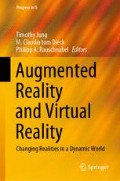Abstract
Virtual reality (VR) has become a new playground for brands and advertisers. However, empirical evidence for the effectiveness of VR branded content is still scarce. The aim of this study is therefore to examine the effectiveness of branded content in virtual space and the role of presence in the processing of brand information when playing a branded VR game. An experiment (N = 81) was conducted (using HTC Vive hardware) and showed that playing branded VR games can improve (implicit) brand memory. Moreover, the study showed that the increase in immersion experienced from playing a branded VR game strengthens players’ brand memory.
Access this chapter
Tax calculation will be finalised at checkout
Purchases are for personal use only
References
Chen, H., & Wang, Y. (2019). Product placement in virtual reality videos from the perspective of dialogic engagement. Journal of Interactive Advertising. Advance online publication.
Evans, N. J., & Park, D. (2015). Rethinking the persuasion knowledge model: Schematic antecedents and associative outcomes of persuasion knowledge activation for covert advertising. Journal of Current Issues & Research in Advertising,36(2), 157–176.
Gabana, D., Tokarchuk, L., Hannon, E., & Gunes, H. (2017). Effects of valence and arousal on working memory performance in virtual reality gaming. In Seventh International Conference on Affective Computing and Intelligent Interaction (ACII, pp. 36–41). IEEE.
Hartmann, T., Wirth, W., Schramm, H., Klimmt, C., Vorderer, P., Gysbers, A., et al. (2016). The spatial presence experience scale (SPES): A short self-report measure for diverse media settings. Journal of Media Psychology,26(1), 1–15.
Hayes, A. F. (2013). Introduction to mediation, moderation, and conditional process analysis: A regression-based approach. Guilford Press.
Klein, L. R. (2003). Creating virtual product experiences: The role of telepresence. Journal of Interactive Marketing,17(1), 41–55.
Lang, A. (2000). The limited capacity model of mediated message processing. Journal of Communication,50(1), 46–70.
Lin, J. W., Duh, H. B. L., Parker, D. E., Abi-Rached, H., & Furness, T. A. (2002). Effects of field of view on presence, enjoyment, memory, and simulator sickness in a virtual environment. In B. Loftin, J. X. Chen, S. Rizzo, M. Goebel & M. Hirose (Eds.), Proceedings IEEE Virtual Reality 2002(pp. 164-171). IEEE.
Lombard, M., & Ditton, T. (1997). At the heart of it all: The concept of presence. Journal of Computer-Mediated Communication, 3(2), JCMC321.
Long, J. S., & Ervin, L. H. (2000). Using heteroscedasticity consistent standard errors in the linear regression model. The American Statistician,54(3), 217–224.
Martínez-Navarro, J., Bigné, E., Guixeres, J., Alcañiz, M., & Torrecilla, C. (2019). The influence of virtual reality in e-commerce. Journal of Business Research,100, 475–482.
Maxian, W., Bradley, S. D., Wise, W., & Toulouse, E. N. (2013). Brand love is in the heart: Physiological responding to advertised brands. Psychology & Marketing,30(6), 469–478.
Preacher, K. J., & Hayes, A. F. (2008). Asymptotic and resampling strategies for assessing and comparing indirect effects in multiple mediator models. Behavior Research Methods,40, 879–891.
Rajaram, S., Srinivas, K., & Travers, S. (2001). The effects of attention on perceptual implicit memory. Memory & Cognition,29, 920–930.
Riva, G., Mantovani, F., Capideville, C. S., Preziosa, A., Morganti, F., Villani, D., et al. (2007). Affective interactions using virtual reality: The link between presence and emotions. CyberPsychology & Behavior, 10(1), 45–56.
Roettl, J., & Terlutter, R. (2018). The same video game in 2D, 3D or virtual reality—How does technology impact game evaluation and brand placements? PLoS ONE,13(7), Article e0200724.
Sanchez-Vives, M. V., & Slater, M. (2005). From presence to consciousness through virtual reality. Nature Reviews Neuroscience,6, 332–339.
Seibert, J., & Shafer, D. M. (2018). Control mapping in virtual reality: Effects on spatial presence and controller naturalness. Virtual Reality,22(1), 79–88.
Solon, O. (2016, October 11). Is our world a simulation? Why some scientists say it’s more likely than not. The Guardian. Retrieved from https://www.theguardian.com/technology/2016/oct/11/simulated-world-elon-musk-the-matrix.
Terlutter, R., & Capella, M. L. (2013). The gamification of advertising: Analysis and research directions of in-game advertising, advergames, and advertising in social network games. Journal of Advertising,42(2-3), 95–112.
Tussyadiah, I. P., Wang, D., Jung, T. H., & tom Dieck, M. C. (2018). Virtual reality, presence, and attitude change: empirical evidence from tourism. Tourism Management, 66, 140–154.
Van Berlo, Z. M. C., Van Reijmersdal, E. A., & Rozendaal, E. (2017). Weet wat er speelt: De rol van merkbekendheid in effecten van mobiele advergames op tieners [The rules of the game: The role of brand familiarity in mobile advergames]. Tijdschrift voor Communicatiewetenschap,45(3), 216–236.
Wise, K., Bolls, P. D., Kim, H., Venkataraman, A., & Meyer, R. (2008). Enjoyment of advergames and brand attitudes: The impact of thematic relevance. Journal of Interactive Advertising,9(1), 27–36.
Witmer, B. G., Jerome, C. J., & Singer, M. J. (2005). The factor structure of the presence questionnaire. Presence: Teleoperators & Virtual Environments, 14, 298–312.
Wang, Y., & Chen, H. (2019). The influence of dialogic engagement and prominence on visual product placement in virtual reality videos. Journal of Business Research,100, 493-502.
Wirth, W., Hartmann, T., Böcking, S., Vorderer, P., Klimmt, C., Schramm, H., et al. (2007). A process model of the formation of spatial presence experiences. Media Psychology,9(3), 493–525.
Acknowledgements
The data that are presented in this paper were collected during a project (314-98-107) that is part of the research programme Creative Industry—Knowledge Innovation Mapping (KIEM). The project was partly financed by the Netherlands Organisation for Scientific Research (NWO) and partly by a private partner (VR Owl).
Author information
Authors and Affiliations
Corresponding author
Editor information
Editors and Affiliations
Rights and permissions
Copyright information
© 2020 Springer Nature Switzerland AG
About this chapter
Cite this chapter
van Berlo, Z.M.C., van Reijmersdal, E.A., Smit, E.G., van der Laan, L.N. (2020). Inside Advertising: The Role of Presence in the Processing of Branded VR Content. In: Jung, T., tom Dieck, M.C., Rauschnabel, P.A. (eds) Augmented Reality and Virtual Reality. Progress in IS. Springer, Cham. https://doi.org/10.1007/978-3-030-37869-1_2
Download citation
DOI: https://doi.org/10.1007/978-3-030-37869-1_2
Published:
Publisher Name: Springer, Cham
Print ISBN: 978-3-030-37868-4
Online ISBN: 978-3-030-37869-1
eBook Packages: Business and ManagementBusiness and Management (R0)

